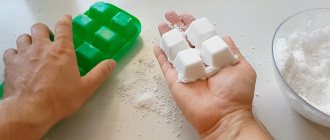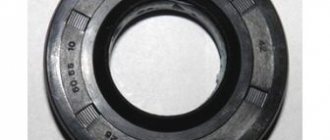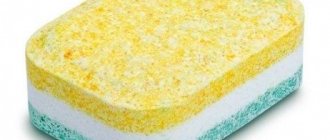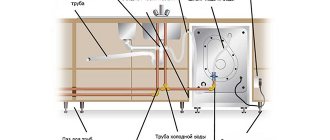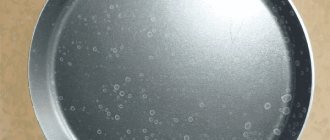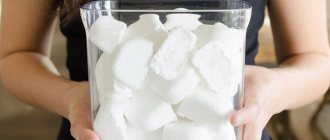The economy must be economical! This is what Brezhnev once said and many housewives completely agree with him, and they especially agree at a time when there is no extra money on hand and the dishwasher has run out of salt. And they have a completely logical thought: how to replace salt for the dishwasher? If it's just salt, then why pay a lot of money for it?
Let's look into this issue together and consider all the options.
Because the fact that it is salt does not mean at all that it is table salt and completely identical. See also:
Basic rules for using a dishwasher
Why do you need salt in the dishwasher?
Like any other household appliance that works with water, a dishwasher is susceptible to scale formation, which can quickly damage the device. To combat this problem, manufacturers have provided the dishwasher with an ion exchanger - a device for neutralizing calcium and magnesium particles, which cause plaque. An ion exchanger is a container that contains a resin with chlorine ions. Tap water passes through an ion exchanger, in which magnesium and calcium particles are bonded with chlorine. This softens the water and prevents scale formation.
Why is there salt in the dishwasher? The fact is that chlorine ions are constantly running out and need to be replenished. By adding salt to the dishwasher, we replenish chlorine reserves and provide the ion exchanger with material for further binding of magnesium and calcium particles.
Is it possible to put regular salt in the dishwasher? Dishwasher manufacturers claim that regular table salt is not suitable for this purpose, as it contains many impurities that can contaminate the appliance. Dishwasher salt is specially purified and the granules are made to a specific size. If you haven’t had time to stock up on dishwasher salt and it’s time to add the next batch, you can turn on the appliance a couple of times without salt at all, but the less you do this, the better for your assistant. In any case, the damage to the dishwasher from washing without salt will be less than from using regular table salt. How often to put salt in the dishwasher is an individual question. If your washing machine does not indicate the depletion of salt with a special signal, it makes sense to replenish the salt reserves once every couple of months.
A dishwasher is an expensive, but extremely useful device in the household. The technology frees us from the daily routine of washing dishes and reduces the consumption of hot water. Each washing cycle involves the use of not only washing tablets and capsules, but also salt for PMM. This essential component softens hard water and increases foaming, without which high-quality dishwashing is impossible.
What is dishwasher salt, which one is most suitable, and how can it be replaced, read the article.
The indicator lights up - it’s time to pour salt
The dishwasher itself signals when it is time to add sodium chloride to the filter. A red light on the panel lights up opposite the icon with arrows diverging in different directions:
Having noticed a signal, you need to take action.
How to add salt correctly:
- Open the dishwasher door and find the filter cover at the bottom.
- Unscrew and insert the funnel into the hole.
- Pour 1 liter of water.
- Pour in 0.7–1 kg of salt.
- We clean up everything that spills and spills out with a sponge.
- Screw on the lid.
The process of reducing the ion exchange resin is completed when the solution becomes homogeneous.
It is better to load the product immediately before using the dishwasher. During operation, the remaining brine solution will be washed away. Contact with metal is not advisable due to the risk of corrosion.
Functions of salt in the dishwasher
The quality of water in most regions of Russia leaves much to be desired. Apartment owners prefer to install filters on water pipes, but they do not always save the situation.
You can determine water hardness by the appearance of the taps in the bathroom and kitchen. White deposits indicate excessive limestone content. Tap water contains a certain amount of calcium ions. When heated, it precipitates, gradually compressing into a thick coat of scale.
If you use tap water for boiling without filtering, the kettle will quickly become covered with scale from the inside. The same thing happens with heating elements in a dishwasher. The heating tube spends more electricity to heat the water, and at a certain point, under the influence of too high a temperature, the spiral burns out.
Most PMMs are equipped with a built-in ion exchange filter with a resin consisting of sodium chloride. Water passes through it, and magnesium and calcium ions with a positive charge are deposited on the resin particles. The water is saturated with sodium ions with a negative charge and becomes softer.
What kind of deposit forms on the dishwasher?
According to the photo, a white coating is visible on the bottom of the dishwasher and on the door.
To check, I drew the word “plaque” on the door of my dishwasher with my finger. Limescale deposits cannot be erased by the touch of a finger; they can only be scratched with your fingernails. From this I conclude that it is not limescale that has accumulated on the bottom and door of my dishwasher over the course of the year, but ordinary dirt, maybe it’s poorly washed off powder.
How do I deal with plaque? I use dishwasher cleaner. The last time I cleaned the dishwasher was a year ago with Finish cleaner. This cleaner is expensive. Therefore, I chose an analogue Lotta cleaner, its price is no more than 200 rubles. Right in the store, I compared the composition of Finish and Lotta, all the components were the same.
Salt for the dishwasher - how and where to add it
The amount of salt and the rate of consumption depend on the hardness of the water . The more limestone it contains, the greater the consumption. Determining the exact content is difficult. The indicator varies from season to season and depends on the technology for cleaning water utilities and the means used for this.
Experts recommend adding salt immediately before washing. To make the granules dissolve better, it is advisable to fill them with water.
Particular attention is paid to the storage of sodium salt - it is highly hygroscopic and loses its effectiveness as moisture is absorbed. The product is stored in a dry place, away from direct sunlight.
How to fill the container and in what dosage
Algorithm for filling the tank:
- Open the door of the dishwasher bin and look into the tray - the reservoir with a lid is located next to the filter for draining the water.
- Open the tank, pour water to the brim and add crystals.
- Remove excess water from the pan.
The consumption of the product depends on the hardness of the tap water. On average, salt reserves are replenished 1-2 times a month in the amount of 750 g. Hard water consumes more product, so you can immediately pour a full tray - about 1 kg of product. If the water is soft, 0.5 kg is enough. This amount is enough for 2 months of regular use of the dishwasher.
Many models of popular PMM brands Electrolux, Miele, Bosch are equipped with a stiffness sensor. Depending on the indicators, the salt supply is adjusted. The indicator on the control panel lights up when supplies are approaching.
Where is the salt compartment?
The required tank can be seen with the naked eye if you open the car door. Notice the gray round lid on the bottom. Where to pour salt in the dishwasher is clearly shown in the photo:
To load, you need to unscrew the cap and fill the tank through the funnel. How much salt will fit in it depends on the dishwasher model. You can find the relevant information in the instructions for the device. The compartment is filled almost completely.
Types of dishwasher salt
Regenerating salt for the dishwasher is produced in tablet form in the form of large granules and finely ground powder. The degree of purification of the salt is important here; it should not contain other chemical elements that contribute to the formation of scale. Real salt for PMM should contain only NaCl. It is completely safe for humans and the environment.
Dishwasher manufacturers simultaneously produce detergents and salt compositions that are ideally compatible with the equipment. The NaCl content of such products is 99.5-99.7%.
Large NaCl crystals are the most optimal form. The size of the granules is 4-6 mm. Powdered, fine salt is characterized by rapid consumption and clogs the PMM ducts.
The tablet form is also a good option, however, not every tank can take the required number of tablets.
List of popular brands:
- Finish Calgonit is a highly purified salt in the middle price segment. Large granules do not contain phosphates. A 1.5 kg package is enough for 30 cycles on average.
- Sodasan produces high quality salt that is not inferior to Finish Calgonit in terms of purity, but the cost of the product is higher. Organic salt has received Eco-Garantie certification. It effectively removes white plaque and prevents the formation of limestone.
- Somat is high-quality salt without foreign impurities. The granules are of medium size, so the consumption is higher - 1.5 kg for 3-4 weeks.
- “Eonit” is a brand of natural salt for PMM. NATURAL does not leave a residue and prevents limescale. Packaging consumption 1.5 kg – for 2 months.
- Top House - the brand produces coarse salt with minimal consumption. The cost is significantly higher than analogues. Packaging consumption 1.5 kg – 3-4 months.
- Topperr is a regenerating salt in tablet and powder form. Saturates water with sodium ions, increases the solubility of detergents and the quality of dishwashing. Extends the service life of PMM and protects metal parts from limescale. Consumption 1.5 kg – for 1 month.
- Clean Fresh - the product contains 99.7% NaCl. Available in the form of granular crystals. Salt consumption is economical due to its slow dissolution in water. Consumption of a pack of 1 kg – for 1-1.5 months.
How is special salt different from regular salt?
We think that you yourself understand that the word “horse” may not always indicate an Arabian horse, but may mean that it is an ordinary pony.
And then try and prove at the races that horses are also ponies! It's the same story with salt. Special salt for dishwashers has two differences from ordinary salt:
- Deepest removal of impurities
- The granulation is not so fine
And these two factors make it a completely different product, although its composition remains ordinary sodium chlorine.
Ordinary salt contains a lot of impurities, even to the extent that there are particles of sand and gypsum. These things completely confuse the ion exchanger, rendering it inoperable, and, in addition, spoil the iron parts, contributing to the very scale that the ion exchanger is designed to fight.
The granulation of such salt is designed so that it dissolves slowly and in no case clogs the ion exchanger filter. That is, if you pour fine salt, it will clog the filter and it will not be able to work at all! Naturally, there will be absolutely no effect, since the saline solution will not reach its destination. After all, as you remember, salt plays only an indirect role and does not reach the plates directly.
What can replace an expensive product?
Dishwasher manufacturers strongly recommend not replacing special regenerating salt with regular or sea salt. Regular table salt contains more than 0.5% iodides, carbonates and fluorides. The degree of purification of raw materials for PMM must be at least 99.5%.
Sea salt contains iodine, so it is not suitable as a substitute. A large amount of additional microelements will increase the risk of scale formation.
However, judging by the reviews of consumers who want to save money, you can still pour well-purified table salt without foreign impurities into the tank.
The main thing is that it is boiled. This information is indicated on the packaging.
Salt marked “EXTRA” is recommended to be poured in the form of an aqueous solution in a concentration of 1:1. This will prevent pressing inside the tank.
2nd option - tableted salt for softener filters
You can replace the salt with this option.
Step 1. Purchase the composition
| |
Step 2: Fill the dishwasher with tablets
| |
Step 3. If you do not intend to use a special option, then use tablets
Is it possible to replace the special option completely? Yes, if you use tablets |
Will table salt damage equipment?
Quite a tempting option for those who like to save money. A pack of table salt costs 15 times less than branded Finish dishwasher salt. And naturally you want to use regular table salt, but is it necessary? Experts say, and experienced users confirm from their bitter experience, that crushed table salt (especially extra grade) should not be used under any circumstances.
The fact is that in a pack of table salt, even coarsely ground, there is quite a lot of suspended matter. The suspension in this case is finely dispersed particles of salt that settle to the bottom of the PMM salt tank. What happens next?
- The suspension crystallizes in a dense layer in the tank.
- Over time, the tank becomes so clogged that water stops passing through it or passes through, but with great difficulty.
The reservoir may become so clogged that it will have to be pulled out of the machine in order to clean it.
- The ion exchanger receives less or a small amount of salt and fails.
- A huge amount of scale settles in the car, causing the equipment to quickly break down.
What absolutely cannot be used as a substitute for special salt?
So, what should not be substituted?
Coarse salt, but dirty, definitely cannot be used.
Salt of a pure, but too fine “Extra” fraction cannot be used either, as it will clog the ion exchanger filter.
Maybe sea salt? No, that's not possible either. Because sea salt is even less refined than regular table salt and is gray in color. Sea salt contains an incredible amount of iodine and other minerals, which are very useful for the human body, but not for iron parts of equipment.
Soda - especially not! In general, throw this idea out of your head, since these are completely different things. And the fact that soda softens water has nothing to do with the ion exchanger. Which will definitely fail from such experiments.
And replacing an ion exchanger is an expensive thing and not at all economical. Can you imagine how many years it would be possible to buy special salt instead of replacing the ion exchanger? Same thing.
Properties of Lotta dishwasher cleaner:
Removes unpleasant odor.
Cleans filters.
Easily removes grease and dirt.
Completely removes scale.
Suitable for all types of machines.
Made in Europe.
Manufacturers, in order to extend the service life of PMMs, recommend cleaning them every six months. Buying a new dishwasher is not easy; it is easier to take care of and operate the machine correctly.
To replace or not to replace?
Experts believe that tablets made from food-grade sodium chloride may be the best replacement for expensive salt formulations. The following facts support them:
- The tablet form allows the product to dissolve evenly and for a long time, maintaining the optimal concentration of sodium chloride ions.
- A 25 kg package is enough for more than 2 years.
- Convenient to lay.
Attention! By replacing a special tool with an analogue, you risk that the equipment will lose its warranty. Therefore, it is better to use cheap substitutes after the warranty has expired.
Replacement options
Dishwasher salt, what is it? The answer that immediately comes to mind is a substance based on the sodium-chlorine compound. Therefore, the first option that users offer to replace special salt is regular table salt. In addition to table salt, some try to use the following as substitutes:
- sea salt;
- tableted salt;
- 3 in 1 tablets.
Table and sea salt
Table salt, also called table salt or rock salt, can have different compositions. Everything will depend on the conditions and methods of extracting raw materials. And this is clear from the appearance of the substance. Some salt is fine, others are coarse, some are very white, others have a grayish tint, and sometimes even gray grains of sand. But 96-97% of any table salt consists of sodium and chlorine. In addition, it may contain: potassium, calcium, magnesium, clay, iron boron, manganese, iodine and other substances, as well as food additives, for example E536.
This composition of table salt suggests that its use in the dishwasher may not be safe. Various impurities will settle in the ion exchanger, which will lead to its rapid wear and breakdown.
Important! If you need to replace special salt, then you need to choose salt of the highest class of processing without any additives, and not iodized. For example, this type of salt includes “Extra” salt.
Dishwasher users are divided into supporters of using “Extra” salt and opponents of replacing special salt. Supporters say that nothing happens to the car, and that 1 kg of such salt is enough for exactly the same amount as 1 kg of special salt. Opponents do not see any point in replacing salt at all, since it lasts for a long time. And for a year of using the car, this is not a lot of money and it’s not worth taking risks in this case.
Sea salt is similar in composition to food salt, but it contains even more different impurities, more than 80 minerals. It undergoes minimal processing and cleaning, so this salt is definitely not suitable for the dishwasher.
Tablet salt
As for tableted salt, it comes in different forms. This can be a special regenerating salt, but it is produced not in granules, but in tablets. But there is also tableted table salt, for example “Mozyr Salt Universal”. Tablets are made based on extra table salt “Polesie”, which does not contain the additive E536. The price for 25 kg of such salt is 350-400 rubles, and it will last for about 2 years, there is a significant saving.
3-in-1 tablets
And finally, 3-in-1 tablets for dishwashers, this cannot at all be called an option for replacing salt for a dishwasher, since this is a full-fledged set of products necessary for it. The tablet consists of several layers, each of which has a certain time to dissolve in water:
- the first and second layers are detergent and salt, they dissolve during the heating of water;
- the next layer is neutral - it dissolves during the first rinse;
- The last layer is rinse aid, which dissolves during the last rinse of the dishes.
The 3-in-1 product can be used instead of all products at once, and there is no need to pour salt into the compartment. However, dishwasher users note that with a long dishwashing cycle, the tablet dissolves normally, but with short cycles, the powder does not always dissolve, which leads to it getting into the rinse water.
For your information! You should not crush 3-in-1 tablets into powder, this will lead to the fact that the rinse aid will dissolve during the dishwashing process and will be of no use.
Simple dishwasher care:
I removed all the dishes from the PMM.
Lotta removed the protective film from the lid of the purifier.
I placed the bottle of cleaner in the basket upside down, hanging it on the glass rack.
I chose a program where the water temperature is above 65 degrees.
No additional detergents are required.
She turned on the dishwasher.
This is what the dishwasher looks like after using Lotta cleaner. It actually washed well and has a pleasant smell. But the white streaks remained at the bottom of the dishwasher. The stains were easily removed with a damp cloth. In general, I am satisfied with the performance of the Lotta cleaner.
The fourteenth of December two thousand and sixteen.
Rating 0.00 [0 Vote(s)]
